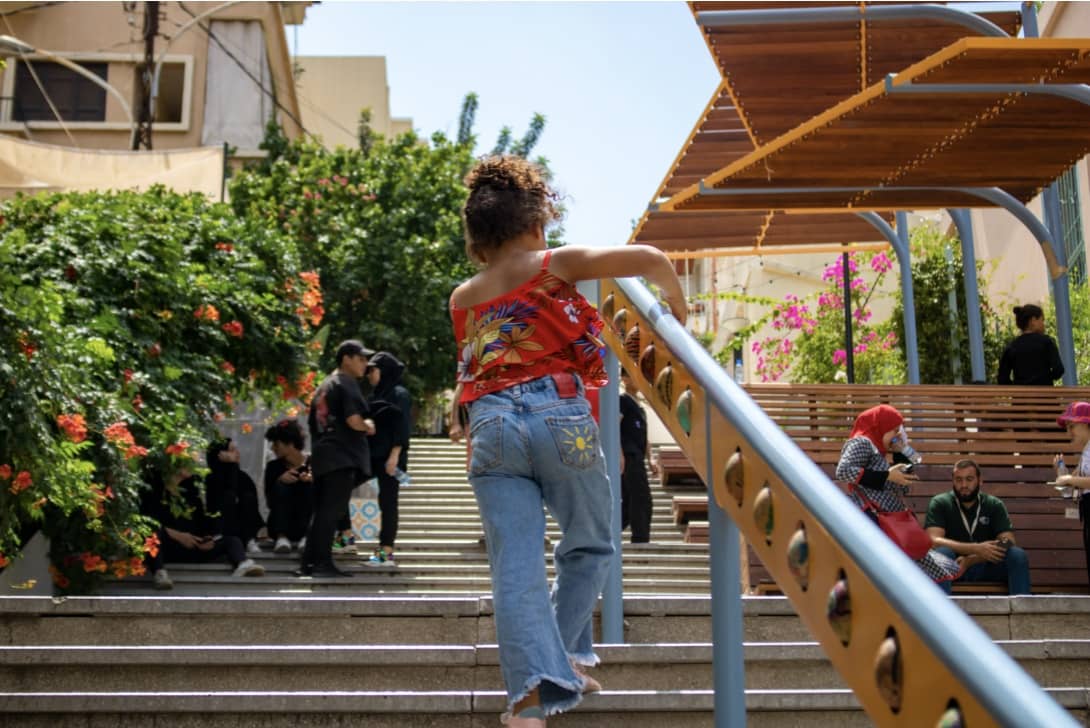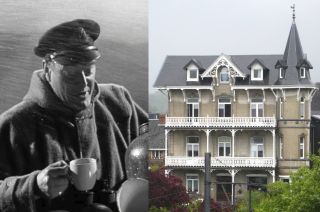
www.buildingsandcities.org/insights/commentaries/designing-cities-girls.html
Designing Cities with and for Girls

Involving women in urban development processes and decisions will make cities better for everyone.
Elin Andersdotter Fabre (UN Habitat) and Tove Levonen (Shared City Foundation) explain why cities need to be more inclusive for women. The UN Habitat 'Her City' project provides a participatory toolkit and process to include women in urban planning, design and development.
Why girls?
A decade ago, UN-Habitat (the United Nations Human
Settlements Programme) initiated the Global Public Space Programme, focusing on
inclusive public space planning and design. Since then, child-friendly
urban public space design has become an increasingly hot topic around the
world. However, the needs of girls (age 0-18) and young women (age 19-25) are particularly
underrepresented in urban public space planning and design and that projects do
not target them as a key user group. Even though the importance of including
this group in urban public space development is clearly recognised in the Sustainable
Urban Development Goals (SDGs) of the 2030 Agenda,
women and girls in vulnerable areas are the most likely to be 'left behind'.
To address that girls are among the most likely to be 'left behind' and rarely
are consulted in rethinking their neighbourhoods or daily lives, Her City was initiated by UN-Habitat
and the Shared City Foundation to provide tools to increase participation in
urban development. Its purpose is to support urban development from a girl's
perspective by focusing on the use of gender and youth
transformative tools and methods.
Her City is the result of the Urban Girls Movement initiative that started with a global mapping of best practices for gender inclusion in urban development back in 2017. These global learnings informed the process then piloted in the first project in Botkyrka in Sweden, testing a planning and design process that is gender, socio-economically and age sensitive.
Urbanism and gender
Already 55% of the world's population live in cities.1 The number is increasing steadily, particularly in intermediate cities and in sub-Saharan Africa. In many countries in the global North, the urbanisation rate has already exceeded 80%.2 This brings about enormous challenges both in terms of sustainability and equality, for example, with poverty becoming an increasingly urban phenomenon.
Among the most affected by inequalities are women in socioeconomically disadvantaged urban areas who experience oppression, lack of opportunities and social exclusion as a result. Women are also affected by the negative impact of climate change to a higher extent than men.3
In general, women and girls benefit less from urbanisation and urban spaces than men and boys.4 Women in cities globally face a range of specific barriers and vulnerabilities, which if not addressed in urban planning, can result in a form of gender-based discrimination. For example, women and girls are systematically excluded and deprived of basic infrastructure, services and opportunities. For example, 60% of women and girls feel unsafe in public spaces worldwide. It ranges from not feeling comfortable when taking a specific path to school or work, using public transport or accessing basic water, sanitation and livelihoods, to simply not spending time outside of home because public spaces are not welcoming or meeting the needs of young women and girls.
This vulnerability further increases when gender is coupled with other grounds for discrimination such as age, economic status, disabilities, minorities, ethnicity or sexual orientation. Women and minorities are unequally represented in decision-making processes, for example only 23% of government positions are occupied by women and only 10% of urban planners. This becomes as a barrier to women and girl's participation in important processes such as climate-related urban planning and policy development. It is hoped that the Her City Toolbox can help change this.
The toolbox
On International Women's Day 2021, the Her City Toolbox was launched and then rolled out in 20 partnership projects in Africa, the Middle East, Asia, Latin America and Europe. Today over 1200 users from 350 cities in 100 countries are registered on the platform and 300 independent initiatives worldwide using the toolbox.
The toolbox follows a unique process, a digital step-by-step guide on how to co-plan cities from a girl's perspective. It is available for free on an open and digitally accessible platform. The 9 blocks represent the three phases of the urban development process and will guide you through the assessment, design and implementation phase. Each block contains a number of activities with detailed steps to follow in order to deliver on your Her City project.
The toolbox provides municipal professionals, urban actors and local decision-makers with a solid toolbox for mainstreaming youth, gender and socioeconomic perspectives by strategically involving girls and young women in urban planning, design and implementation. The toolbox has been introduced to 8,000 stakeholders and 1,000 professionals are proficient in using the tools. Besides, providing capacity building, UN-Habitat's role is to support cities in facilitating the ongoing dialogue between professionals and citizens.
The results
The Her City process has shown the value of including underrepresented perspectives in local decision-making processes and physical planning and design of urban spaces. Well-planned public spaces - or participatory processes - open for all regardless of ethnic origin, ability, sexual orientation, age or gender. When these perspectives are included as well, the overall picture is more complete, solutions can be developed to fit the entire population, and decision makers are adequately informed to take long-term and sustainable decisions.
Girls and other disadvantaged groups prioritise the usage of public resources in a way that touches cross-cutting issues. When consulted, girls raise pressing urban planning issues such as crime prevention measures, ecosystem solutions, transport, access to education and healthcare. The results are inclusive and cost- efficient public spaces that work for everyone. Though the long-term impact is too early to measure, we can see tendencies in our partnership projects where the process has led to lasting impact on the physical public space with consequences for the entire community.
Among the 20 projects, 10 public spaces have been rebuilt so far, providing space for 52,000 people living in direct proximity. Despite different geographical contexts, similar priorities and solutions are proposed by the girls. Girls were found to have different priorities and design solutions than boys, valuing developments that have 'common good' and long-term sustainable consequences for both "people" and 'planet'.
The top solutions proposed by girls were greening of the urban environment (trees, flowers, parks urban agriculture, beehives, and ecosystem services), increased arts provision (library, stages, interactive lights and outdoor theatres), public spaces (ponds, pools and fountains chill and recreational areas, meeting points and playgrounds) increased public amenities (water drinking taps, public toilets, pedestrian streets. cycle paths and waste and recycling facilities).
Besides improvement in the physical environment, the process also showed value for the different target groups involved - the girls, but also for other stakeholders involved such as local decision-makers, urban professionals, or academia:
- The process was observed to strengthen the girls' trust in society and public authorities and the ability to influence their local environment increased civic engagement among some of the girls. In addition, the close collaboration with the multi-stakeholder group also serves as an introduction to the labour market, shows the inner workings of a variety of professions, and provides insight into local democracy processes.
- The feedback from participating professionals indicates that working in close partnership with girls and 'non-professionals' has served as an eye-opener to understand the space and needs from the girls' perspective. Her City therefore continues to build capacity among multi-stakeholder professionals.
- Her City was developed together with researchers into an academic course that was first piloted at the Technical University of Crete in Greece and at the Bauhaus University in Germany showing that live Her City projects can inform and build capacity among young scholars by training the urbanists, planners, designers and architects of tomorrow.
- The structural impact of Her City initiatives has influenced policy or governance processes. In South Africa, for the first time positive discrimination of women was allowed in public procurement. In Peru accessibility regulations is being reviewed from a more inclusive lens. In Palestine, a nationwide public space policy has been developed; and in Sweden. In Botkyrka where it all started, the recommendations by the girls are informing new projects by the municipality, private actors and community organisations.
The new normal
Involving girls in urban development will make the city better for everyone. When girls are given the trust and opportunity, they plan and design with diversity and different needs in mind. Participatory processes are key for planning a city that can work for everyone. Through Her City we have had the possibility to re-think and systematically restructure and speed up the transition to an inclusive and sustainable urban environment by broadening priorities and points of view. Her City should be the new normal.
Notes
1 UN Habitat. (2022). World Cities Report 2022: Envisaging the Future of Cities.
2 World Bank. (n.d.) Urban population (% of total population).
3 UN Women. (2022). Explainer: how gender inequality and climate change are interconnected.
4 UN-Habitat. (2022). Cities for Girls, Cities for All: Report from the Vinnova Innovation for Gender Equality Project.
Latest Peer-Reviewed Journal Content
Designing for pro-environmental behaviour change: the aspiration–reality gap
J Simpson & J Uttley
Lifetimes of demolished buildings in US and European cities
J Berglund-Brown, I Dobie, J Hewitt, C De Wolf & J Ochsendorf
Expanding the framework of urban living labs using grassroots methods
T Ahmed, I Delsante & L Migliavacca
Youth engagement in urban living labs: tools, methods and pedagogies
N Charalambous, C Panayi, C Mady, T Augustinčić & D Berc
Co-creating urban transformation: a stakeholder analysis for Germany’s heat transition
P Heger, C Bieber, M Hendawy & A Shooshtari
Placemaking living lab: creating resilient social and spatial infrastructures
M Dodd, N Madabhushi & R Lees
Church pipe organs: historical tuning records as indoor environmental evidence
B Bingley, A Knight & Y Xing
A framework for 1.5°C-aligned GHG budgets in architecture
G Betti, I Spaar, D Bachmann, A Jerosch-Herold, E Kühner, R Yang, K Avhad & S Sinning
Net zero retrofit of the building stock [editorial]
D Godoy-Shimizu & P Steadman
Co-learning in living labs: nurturing civic agency and resilience
A Belfield
The importance of multi-roles and code-switching in living labs
H Noller & A Tarik
Researchers’ shifting roles in living labs for knowledge co-production
C-C Dobre & G Faldi
Increasing civic resilience in urban living labs: city authorities’ roles
E Alatalo, M Laine & M Kyrönviita
Co-curation as civic practice in community engagement
Z Li, M Sunikka-Blank, R Purohit & F Samuel
Preserving buildings: emission reductions from circular economy strategies in Austria
N Alaux, V Kulmer, J Vogel & A Passer
Urban living labs: relationality between institutions and local circularity
P Palo, M Adelfio, J Lundin & E Brandão
Living labs: epistemic modelling, temporariness and land value
J Clossick, T Khonsari & U Steven
Co-creating interventions to prevent mosquito-borne disease transmission in hospitals
O Sloan Wood, E Lupenza, D M Agnello, J B Knudsen, M Msellem, K L Schiøler & F Saleh
Circularity at the neighbourhood scale: co-creative living lab lessons
J Honsa, A Versele, T Van de Kerckhove & C Piccardo
Positive energy districts and energy communities: how living labs create value
E Malakhatka, O Shafqat, A Sandoff & L Thuvander
Built environment governance and professionalism: the end of laissez-faire (again)
S Foxell
Co-creating justice in housing energy transitions through energy living labs
D Ricci, C Leiwakabessy, S van Wieringen, P de Koning & T Konstantinou
HVAC characterisation of existing Canadian buildings for decarbonisation retrofit identification
J Adebisi & J J McArthur
Simulation and the building performance gap [editorial]
M Donn
Developing criteria for effective building-sector commitments in nationally determined contributions
P Graham, K McFarlane & M Taheri
Join Our Community

The most important part of any journal is our people – readers, authors, reviewers, editorial board members and editors. You are cordially invited to join our community by joining our mailing list. We send out occasional emails about the journal – calls for papers, special issues, events and more.
We will not share your email with third parties. Read more



Latest Commentaries
COP30 Report
Matti Kuittinen (Aalto University) reflects on his experience of attending the 2025 UN Conference of the Parties in Belém, Brazil. The roadmaps and commitments failed to deliver the objectives of the 2025 Paris Agreement. However, 2 countries - Japan and Senegal - announced they are creating roadmaps to decarbonise their buildings. An international group of government ministers put housing on the agenda - specifying the need for reduced carbon and energy use along with affordability, quality and climate resilience.
Building-Related Research: New Context, New Challenges
Raymond J. Cole (University of British Columbia) reflects on the key challenges raised in the 34 commissioned essays for Buildings & Cities 5th anniversary. Not only are key research issues identified, but the consequences of changing contexts for conducting research and tailoring its influence on society are highlighted as key areas of action.